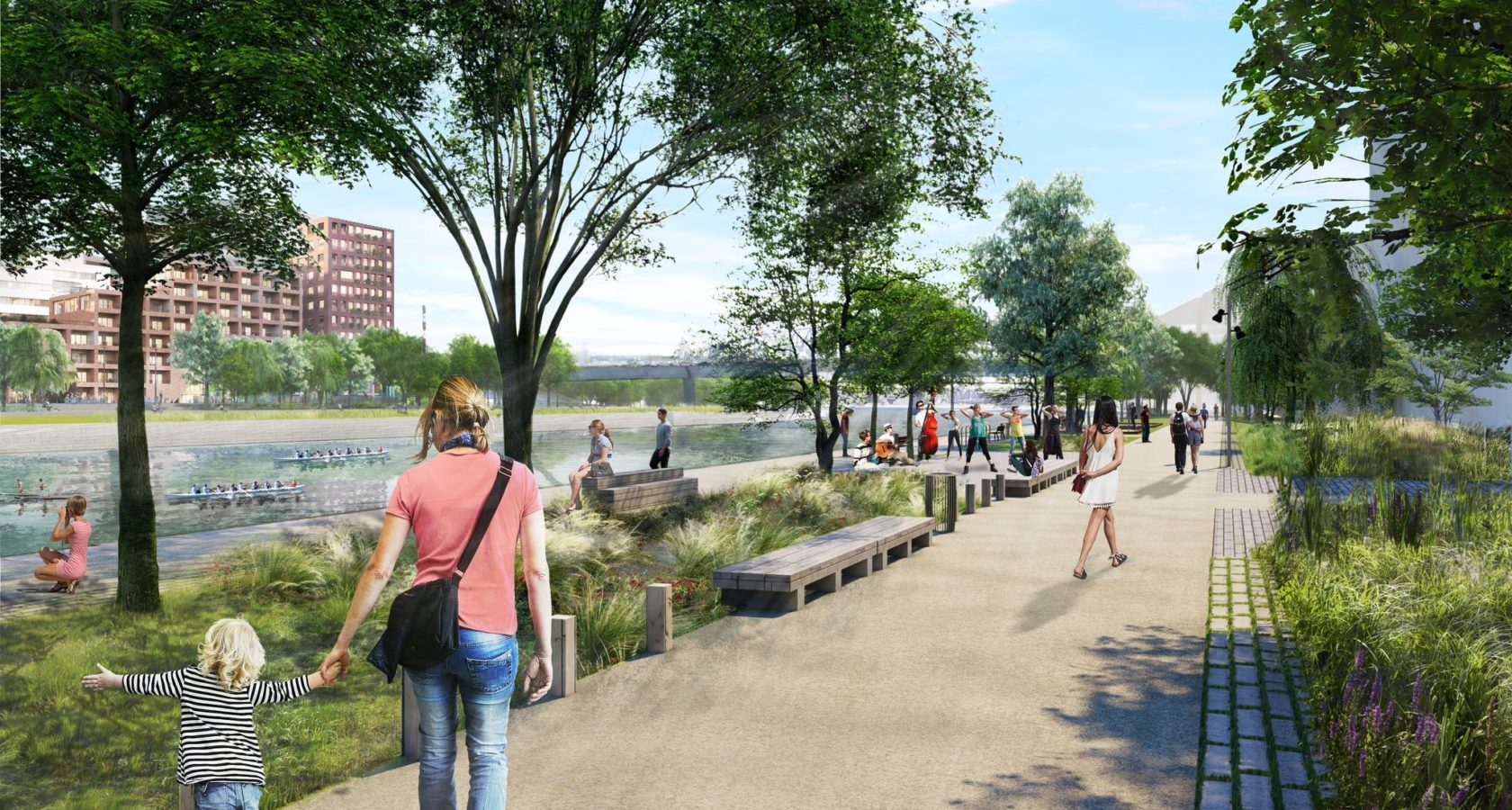Once streets are freed of congestion, once nature is able to re-assert itself, and once shops, sports and cultural activities are readily available on the doorstep, a district can take on a village air again. In the Citadelle, Starlette, Coop and Port du Rhin districts we are able to take our time and to make the spaces our own.
With the new urban project contact with nature is paramount, with green spaces at the heart of apartment blocks, minimal soil sealing, parks and tree-lined alleys, and grassy riverbanks making the connection with the landscape of the tributaries and islands of the Rhine. Everywhere, our gaze is drawn to the water and the natural surroundings, as all the while the bustle of urban and cultural life continues.
Strolling by the water
Green and public spaces account for a total of 40 hectares, i.e. a third of the entire project area, a distinctive feature being that, for the most part, such spaces are designed, made and, above all, planted prior to the building construction phase, ensuring that pedestrians and new residents have the enjoyment of mature trees and pleasing green public spaces from the outset. Roads are transformed into walkways, quays into grassy riverbanks, crossroads into squares, and streets into tree-lined avenues. A total of more than 2 000 trees will be planted, adding to the thousand or so already present.
3 main walkways offering views over the river landscape
- Citadelle quayside walkway (Quai Florence Arthaud): in a city-port atmosphere, the quays with their restaurants and shops are an invitation to stroll. The new park at the Northern Tip is connected to the Parc de la Citadelle by a new footbridge.
- Starlette quayside walkway: along the Vauban basin, a linear park offers a panorama over the port basins and views over the Cathedral and wider landscape beyond.
- Rhineland walkway: a continuation of the Jardin des Deux-Rives gardens, these 3 hectares of linear garden are ideal for a stroll or for open-air sports.
A succession of 4 parks between the Citadelle district and the Jardin des Deux-Rives
- Parc du Petit Rhin: this vast park of 5.6 hectares of splendid landscape is situated on the former Petit Rhin canal which was filled in and covered over in the 1950s. In the centre, a large and refreshing ditch, a mass of wild and lush vegetation, is reminiscent of the Alsatian fens.
- Parc de la Pointe Nord of the Citadelle district: the northern banks of the peninsula form a raised greened walkway along the rue de Nantes dyke with, at the tip, a vast garden extending down to the water. The park is connected to the Parc de la Citadelle by a new footbridge which spans the river basins.
- Parc de la Citadelle: 11 hectares of park open up to the new district via the new footbridge.
- Jardin des Deux-Rives: this 40 hectare garden straddling the border with 25 ha on the French side and 15 ha on the German side is extended in the form of a new landscaped walkway along the Rhine (60 m wide, 500 m long).
These spaces draw attention to the green and blue contours that weave their way through the landscape. One aim is to connect the Neuhof forest with that of the Robertsau by converting the former bed of the Petit Rhin into a park. It is all about creating continous new green spaces throughout the area, re-greening mineralised spaces, and protecting existing green spaces.
Just breathe!
Public spaces are designed first and foremost to be shared spaces for relaxation, sport and leisure, and pleasurable moments spent in good company.
Sport, whether indoor or outdoor, is omnipresent:
- In the parks and on the quays, with dedicated sports areas, circuits, and apparatus,
- In the Rives et Port du Rhin district, where a new “sports plain” (part of the plan to convert the “hat-trick” site of the old customs yard) will allow the young and the not so young to engage in outdoor sports and leisure activities,
- A study is currently looking into the possibility of developing community sports facilities, in particular in conjunction with local schools.
Shops, bars and restaurants: local shops, mini-markets, greengrocers, bakers, chemists, bike shops, hairdressers are all to be found close to the apartment blocks and in the immediate vicinity of the tramstops. Bars and restaurants line the quays and transform the hearts of the districts into lively squares around the Citadelle Halles area, the Coop, the banks of the Rhine, and the Starcoop tramstop.
The Coop is the site of a wide range of cultural and creative activities:
- The Virgule is already home to groups of artists and craftspeople – la Maison d’angle, le Préau, la Menuiserie, Ateliers Bois, Garage – exhibition and cultural mediation spaces, a fab lab, etc.
- In the Cavina, a group of visual artists – the Basse-Cour des Miracles – works together on joint projects and organises exhibitions and events,
- The Union Sociale is the study and conservation centre of the authority in charge of managing the City’s museums (Musées de la Ville de Strasbourg) and provides a cultural mediation space open to the public,
- The Cave à Vins will play host to big cultural events on its vast upper floors, as well as housing a restaurant.

